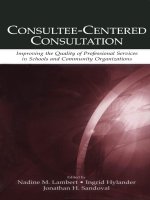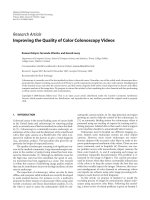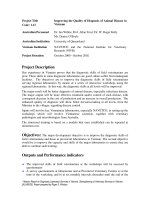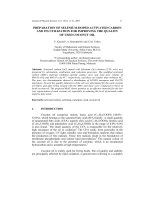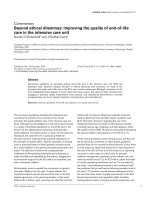Management innovations towards improving the quality of eduacation in ha noi
Bạn đang xem bản rút gọn của tài liệu. Xem và tải ngay bản đầy đủ của tài liệu tại đây (4.24 MB, 135 trang )
MANAGEMENT INNOVATIONS TOWARDS IMPROVING THE
QUALITY OF EDUCATION IN HANOI
___________________________
A DISSERTATION
Presented to the Faculty of the Graduate School
Southern Luzon State University, Lucban, Quezon, Philippines
in Collaboration with
Thai Nguyen University, Socialist Republic of Vietnam
___________________________
In Partial Fulfillment
of the Requirements for the Degree
Doctor of Business Administration
___________________________
By
LE NGOC QUANG (LANOS)
December 2013
i
APPROVAL SHEET
The Dissertation of
LE NGOC QUANG
entitled
MANAGEMENT INNOVATIONS TOWARDS IMPROVING THE
QUALITY OF EDUCATION IN HANOI
Submitted in Partial Fulfilment of the Requirements for the Degree
DOCTOR OF BUSINESS ADMINISTRATION
A program offered by Southern Luzon State University,
Republic of the Philippines in collaboration with
Thai Nguyen University, Socialist Republic of Vietnam
has been approved by Oral Examination Committee
CONRADO L. ABRAHAM, PhD
Expert
JOANNA PAULA A. ELLAGA, DBA
Expert
MELCHOR MELO O. PLACINO, PhD
Expert
NELLY I. MENDOZA, DBA
External Panel
CECILIA N. GASCON, PhD
Chairman
Endorsed by:
Recommended by:
EDWIN P. BERNAL, DBA
Adviser
APOLONIA A. ESPINOSA, PhD
Dean
Accepted in Partial Fulfilment of the Requirements for the Degree
Doctor of Business Administration
_____________________
Date
WALBERTO A. MACARAAN, EdD
Vice President for Academic Affairs
ii
CERTIFICATE OF ORIGINALITY
iii
ACKNOWLEDGMENTS
To finish this dissertation, I needed help from many people who have
been very helpful and supportive of me and to whom I am deeply grateful and
indebted .
First of all, I wish to thank Dr. Edwin P. Bernal, my adviser, because
without his support and advice I would not have been able to finish my work.
His very high requirements had encouraged me to try my best.
I also want to thank all my professors and staff of Southern Luzon
State University and Thai Nguyen University for their insights and suggestions
, providing me with sufficient knowledge and skill to write this dissertation, and
more importantly, to work for my future.
I have also asked the help of principals and teachers of schools in
Hanoi City to provide me with vital information regarding my study without
which my dissertation would not have been completed. I want to give my
sincere thanks to them for their valuable cooperation and kind help.
I would like to thank Hanoi Education and Training Department,
People’s Committee of Dong Anh District and all commentators who gave me
their precious time and effort.
Lastly, I am indebted to many other people. They are writers of useful
materials in books, internet, and newspapers.
LE NGOC QUANG - LANOS
iv
DEDICATION
This dissertation is wholeheartedly dedicated
to my parents, my wife, my children, my classmates and friends.
I express my special thanks from the bottom of my heart
to my parents who brought me into the world and who brought me up.
Also, I am indebted to my wife and children,
who have always been my source of inspiration.
I am grateful to all
my classmates and friends
who helped me research, gather and collect materials in the preparation
of the dissertation.
Their assistance helped me to save my limited time to focus on writing.
LNQ
v
TABLE OF CONTENTS
PAGE
TITLE PAGE ………………………………………………………………..
i
APPROVAL SHEET ……………………………………………………….
ii
CERTIFICATE OF ORIGINALITY ………………………………………..
iii
ACKNOWLEDGEMENT …………………………………………………..
iv
DEDICATION ………………………………………………………………
v
TABLE OF CONTENTS …………………………………………………..
vi
LIST OF TABLES ………………………………………………………….
viii
LIST OF FIGURES ………………………………………………………...
x
LIST OF APPENDICES …………………………………………………...
xi
ABSTRACT …………………………………………………………………
xii
CHAPTER
I
II
III
INTRODUCTION ……………………………………………
1
Background of the Study …………………………………..
1
Objectives of the Study …………………………………….
3
Significance of the Study …………………………………..
4
Scope and Limitations of the Study ………………………
5
Definition of Terms ………………………………………….
6
REVIEW OF LITERATURE ……………………………….
8
Theoretical Framework ………………………………….…
27
Conceptual Framework ………………………………….…
31
METHODOLOGY …………………………………………..
34
Locale of the Study …………………………………………
34
Research Design ……………………………………………
34
Data Gathering Procedure …………………………………
35
Population, Sample and Sampling Technique …..………
36
Research Instrument ……………………………………….
37
Statistical Treatment ………………………........…….……
38
vi
IV
RESULTS AND DISCUSSIONS ………………………….
V
SUMMARY OF FINDINGS, CONCLUSIONS AND
39
RECOMMENDATIONS
Summary of Findings ………………………………………
86
Conclusions …………………………………………………
92
Recommendations …………………………………………
93
REFERENCES ………………………...…………………………………..
98
APPENDICES ……………………………………………………………...
99
CURRICULUM VITAE …………………………………………………….
122
vii
LIST OF TABLES
TABLE
PAGE
1
General Information on Survey Respondents
41
2
Respondents Classified by Type and Grade of Schools
44
3
School Managers’ and Teachers’ Training Standard and
Capability to Use Foreign Language and Information
Technology (IT)
49
Students’ Performance in National High School Exit
Examinations
55
Performance of Hanoi-based Schools in the National
University Entrance Examinations
56
Distribution of Schools in Hanoi as of School Year 20122013
59
Frequency Distribution of Electronic Instructional Materials
as of SY 2012-2013
62
Frequency Table on the Degree of Compliance to
Assigned Tasks
64
Difficulties Faced by Public Schools in Relation to
Financial Sources
70
Assessment Ratings by Managers and Teachers on
Training Curricula
72
Assessment Ratings by Managers and Teachers on
Training Curricula Classified by Grade of Schools
74
Proposed Solutions for Developing High-Quality
Educational Services in Hanoi
76
Proposed Solutions for Managing Responsive Educational
Services
78
Solutions for Ensuring Equality between Public and NonPublic Schools
80
Proposed Solutions for Improving Training Quality of
Foreign Languages and Informatics in Hanoi
84
4
5
6
7
8
9
10
11
12
13
14
15
viii
TABLE
16
PAGE
General Solutions for Improving Educational Quality in
Hanoi
ix
85
LIST OF FIGURES
FIGURE
PAGE
1
Vietnam Education and Training System
10
2
GMR2005 Framework for Understanding Education Quality
26
3
Overview of the Process of Developing Improvement
Actions
28
4
Activities in Identifying Critical Dimensions and Processes
29
5
Activities in Proposing Improvement Actions
30
6
Activities of Implementing and Reviewing Progress
31
7
Conceptual Framework for the Study of the Management
Innovations for Improving the Quality of Education in Hanoi
32
Faculty Trend in Hanoi Schools from SY 2000-2001 to SY
2009-2010
45
Education Centers Meeting MET Standards as of May 20,
2013
57
Opinions of Managers About the Inadequacy of Existing
Mechanisms for Assigning Tasks to Public Schools
65
Proposed Solutions For Promoting International Integration
In Education In Hanoi
82
8
9
10
11
x
LIST OF APPENDICES
APPENDIX
PAGE
A
Survey Questionnaire
100
B
List of 100 Schools
114
`
xi
ABSTRACT
Title of Research
: MANAGEMENT INNOVATIONS TOWARDS
IMPROVING THE QUALITY OF EDUCATION IN
HANOI
Researcher
: LE NGOC QUANG (LANOS)
Degree Conferred
: DOCTOR OF BUSINESS ADMINISTRATION
Name and Address
of Institution
: Southern Luzon State University Lucban, Quezon,
Philippines and Thai Nguyen University, Socialist
Republic of Vietnam
Adviser
: Dr. Edwin P. Bernal
Year Written
: 2013
______________________________________________________________
Of the 1,481 schools in all levels. In this dissertation, 100 schools were
surveyed to identify some management innovations to raise the quality of
education in Hanoi.
Suggestions include: (a) identifying the non-negotiable (compulsory)
subjects to be adopted uniformly by all public and private schools: (b)
schools should be allowed to openly negotiate school fees dependent on
parents’ capacity to pay; (c) proactively apply suitable teaching methods; (d)
high-quality programs must be uploaded in school website; (e) DOET should
formulate and issue acceptable and achievable criteria/standards; (f) DOET
should adopt a system for conducting licensure examinations to maintain a
rooster of registered licensed professionals.
Government should treat public and private schools equally by
granting: (a) proportionate budgets based on enrolment; (b) equal treatment
for taxation ; (c) equal preferential treatment for land use (rent or transfer); (d)
equal treatment for obtaining government loans for schools and infrastructure;
xii
(e)
equal treatment for educational socialization; and (f) equal pay and
bonuses among teachers of public and private schools.
Government’s policy towards national integration must be through: (a)
facilitating the shift from the “input” approach to the "outcome" approach to
education; (b) hiring some international organizations to look into the quality of
schools in Hanoi; (c) allowing schools to adopt advanced educational
programs from abroad; (d) encouraging foreign investment for establishing
foreign schools in Hanoi; and (e) institutionalizing PISA assessment for all
students.
As to return in human capital investments, the government (DOET)
should make some innovations by (a) investing in appropriate facilities; (b)
allowing schools to organize additional (voluntary) classes for foreign
languages and informatics; (c) allowing pupils to learn these subjects outside
school and take revalidation, accreditation or equivalency exams at their
respective schools; and (d) encouraging and recognizing good teachers to
consistently write their experiences and share them with colleagues.
xiii
1
Chapter I
INTRODUCTION
According to the International Organization for Standardization (ISO
9000), the product quality is measured by the degree of conformance to the
collection of characteristics of predetermined specifications and standards.
The quality of products and services creates a trademark, prestige and the
existence of an organization in current circumstances.
On one hand, the Department of Education Standard School-Ministry
of Education and Training 2010 posits that quality education can make
progress. The capability of the students to access and gain new knowledge is
seen as a step towards advancement in life. Achieving quality education,
therefore, must be taken seriously. However, given the limitations, the desired
quality of education in Hanoi has not yet been achieved as expected.
Background of the Study
The Hanoi 2020 Vision 2030 approved by the City People's Committee
in July 2012 defined quality education and training comprehensively.
Accordingly, in 10 years, the education and training sector should have strived
and achieved good results in expanding access to opportunities; developed a
wide range of school types and forms of learning; implemented innovative
education and improved the quality of staff; the education law and the
traditional education are enhanced; the solidification program, school
modernization investment priority, and the number of schools increased
2
rapidly to national standards; the management of education system has had
significant innovations in the direction of increased decentralization, autonomy
and social responsibility in performing the assigned tasks, organizational
structure, staffing and in financing of public schools; and, the models of
private schools and other educational institutions have elements coming from
or influenced by best practices from foreign countries which were gradually
put into effective operation, and at the same time attracting resources for
social investment to education and training for sustainable development.
The
motto
of
educational
development
is
“standardization,
socialization, modernization and democratization.” Hanoi capital which is the
center of politics, science and economy of the country needed to respond
aggressively to the aims of this educational development. Therefore,
improving the quality of education should become a very urgent concern in
order to create a workforce with the necessary knowledge, skills and attitude
required at meeting the requirements of socio-economic development in the
Hanoi capital.
However, the education system is without any pressing issues and
concerns. It is still far from responding very effectively and efficiently to the
call of the times. In particular, the quality of education in Vietnam is still
generally wanting. It is in this context that this research project was
conducted.
3
Objectives of the Study
With the end-goal of improving the quality of education, this research
focused on the following specific objectives:
1. To describe the condition of human capital and material resources in
Hanoi-based schools in terms of professional qualifications of school
managers and faculty, faculty complement, prevalent human resource
management practices, school managers’ and teachers’ training
standard and capability to use foreign language and information
technology, student enrolment, students’ performance evaluation,
school distribution in Hanoi, education socialization; and library and
other learning facilities.
2. To obtain from the research respondents and describe their perception
on the responsiveness of the selected school management inputs such
as assigned tasks, financial system, and school curricula, in
responding to the need of effectively managing the educational system.
3. To describe the respondents’ desired improvements for an effective
management of educational system towards achieving responsiveness
in educational services, equality between public and non-public
schools, comprehensive international integration, and improved quality
of training in foreign languages and informatics.
4
Significance of the Study
This research work will be very significant to the following:
For the Department of Education and Training Hanoi, People's
Committee of Hanoi City, People's Committees of districts, Education
and Training, this research can be valuable inputs in formulating their plans
and strategies in improving education and training in Hanoi.
For students and future researchers, this study can provide an array
of rich data useful for understanding the status and the problems being faced
by the education managers in Hanoi. Further, this can serve as a ready
reference towards deeper study of the other issues and the corresponding
improvements that the educational system needs to undertake in the future.
For students, this research is very important as it is hoped that this will
result to improved school management apart from the old. Quality teaching
will allow educational institutions to come closer to the educational mission of
the century – “learn to know, learn to work, learn to live, and learn to express
oneself.” The students are expected to be able to acquire knowledge, skills
and attitude to become honest, responsible, empathic, optimistic, active, and
creative citizens.
For the students’ parents, this research will help them develop a
more realistic view of quality education. As a result, they will be expected to
make intelligent choices for their kids’ learning environment. At the same time,
they can help create the best educational environment at home. They will be
5
given the opportunity to react positively and cooperate with the schools in
educating their children.
For managers in Hanoi, this research will be meaningful to them as
they will be able to see their weaknesses and strive to institute suitable
changes for the education sector.
For teachers, this research will help them work on changing the
content and methods of education. The parents are also encouraged to invest
in teaching conditions and educational methods for their children.
For potential investors in the education sector, including the
government, businesses, private companies, etc., this research will serve
as a potent source of good reference especially for those who aspire to create
an innovative educational environment. For foreign and domestic investors
who spend money on private schools, they can use this research to update
themselves on government’s policies and regulations and thereby be properly
guided in their decisions when investing.
Scope and Limitations of the Study
This study covered the primary schools, middle schools, and high
schools in both the private and public sectors which are under the jurisdiction
of the Hanoi Department of Education and Training. Particularly, the research
work delved into the human capital and material resources, responsiveness of
the selected school management inputs, and the possible improvements in
the management of education system in Hanoi, Vietnam. The data used to
6
analyze the situation in the educational system of Hanoi were taken from
available documents from 2003 to 2012, while the primary data were gathered
from teachers and school managers from the aforementioned schools.
While the respondent-teachers and school managers have countless
innovative ideas on how to improve the quality of education in Hanoi, the
domestic policy and the political institutions were some concerns beyond the
control of the researcher, hence these were considered research limitations.
In addition, the economic downturn in Vietnam led to social security problems;
hence investment in development programs including infrastructures in
educational sector had become limited. Therefore, this may have a serious
effect on the respondents’ perception on the quality of education in Hanoi
which was not statistically measured.
Definition of Terms
The following terms were defined on the bases of how they were used
in this study:
Comprehensive international integration refers to the ability of the
educational system in Hanoi to enhance the quality of education by
bringing the factors contributory to excellent education, i.e., school
curricula, management system, and school facilities and physical
equipments, are at par with the international standards thereby making
the graduates in primary, middle and high schools ready to face the
rigors of college education which prepares students to become
competitive locally and globally.
7
Education socialization refers to the method used to gain essential
purposes of education where the government, in all cases, always
takes responsibility, and doesn’t entrust it to others. According to
resolution 05 of the government (18th April, 2005), the government is
committed to increasing socialization of the educational, medical,
cultural and sports activities. In particular, for the education and
training, the government is expected to continue increasing investment
budget for the education and training; channel resources of
departments, levels, business and social organizations and individuals
to develop education and training; innovate on the activities of the
public schools and the school fee systems; and enhance the non-public
schools.
Management innovations refer to the recommended strategies, policies and
mechanisms intended to improve the quality of educational services.
Quality of education refers to the value of conversion. A quality education is
an education that effect positive changes on the students coming from
the public and private educational institutions offering primary, middle,
and high school education under the jurisdiction of the Hanoi
Department of Education and Training.
Responsiveness of school management inputs refers to the expected
effect of the assigned tasks, the financial system, and the school
curricula on the management of educational institutions in Hanoi.
8
Chapter II
REVIEW OF LITERATURE
This chapter presents the related literature and studies reviewed by the
researcher from the world wide web, journals and various libraries in the hope
of having the study yield better results. The discussion of related literature
brings into light what educational management and quality education are all
about both in the global arena and in Vietnam. On the other hand, the review
of related studies distinguishes different studies undertaken by a number of
research projects on the relevant variables in this research. This chapter also
presents the theoretical framework and the conceptual framework.
It is an undeniable fact that, in general, education is a vital mover of the
economy. Needless to say the need to imbibe a culture and mindset of quality
education is an undertaking that every nation should strive to embrace, attain
and eventually benefit from. To date, however, while, programs and serious
initiatives both by the national and the local governments had been
undertaken, quality of education in Vietnam is still wanting.
This part of the study will present literatures, articles and writings that
will tell the story of how education has become what it is today. As in any
case, a means to understand something is to understand its beginnings.
Initially a history of the origins of Vietnamese educational system is
presented. The discussion proceeded by highlighting the practices and
experiences from other countries, including the Philippines, from which
lessons may be learned. Finally, the current and proposed educational
9
programs of the country are discussed in order to offer readers with some
basis for understanding where the Vietnamese education is heading to.
The Vietnamese Educational System in a Nutshell
The pre-school takes care of the raising, caring and educating children
from three months to six years of age. The primary education takes a five
year duration grade one up to grade five. The average age of students in
grade one is six.
The secondary education is completed in four-year time from grade
six to grade nine. The student finishes primary education at the age of
eleven. The high school lasts in three years, from grade ten to grade twelve.
Students attending grade ten must have the certificate of graduation from
secondary school at the age of fifteen.
The vocational education has vocational secondary school and
vocational school (primary, secondary, and college). Meanwhile, the
professional intermediate may be completed within three to five years of
learning for people with secondary school certificate, and within one to two
years of learning for people with high school certificate.
Career development maybe completed within one year for beginner
level, and from one to three years for intermediate and upper levels. The
tertiary and post-graduate education trains college level, graduate level,
master level, and doctor level.
Tertiary education. The college education has a duration of two to three
years depending on majors for people with high school or vocational
secondary school certificate; from one year and a half to two years for people
10
with vocational school certificate of the same majors. The undergraduate
education is completed from four to six years depending on majors for people
with high school or vocational school certificate; from two years and a half to
four years for people with vocational school certificate of the same major; from
one year and a half to two years for people with college certificate of the same
major. The master education takes from one to two years for people with
Figure 1. Vietnam Education and Training System
(According to educational laws 2005)
11
undergraduate degrees. The doctor education takes place within four years
for people with undergraduate degrees, from two to three years for people
with master degrees. In special occasions, the duration of doctor education
can be extended depending on the decision of the Education and Training
Department.
Currently, Vietnam has some 3 million university and college students.
Nearly 15 million students (14,762,961) are in the primary, secondary and
high school levels, and nearly 4 million (3,873,445) children are enrolled in the
kindergarten level. On the one hand there are about 84,000 teachers in
various universities and colleges. 1,670,000 teachers are in the primary,
secondary and high schools.
There are about 400 universities and colleges, 15,400 primary schools,
10,600 secondary schools, and 2,350 high schools. Other educational
facilities such as kindergartens, regular education, and community learning
centers add up to 13,500.
Some Practices in Educational Management in Other Countries
William R. Tracey (2003), in The Human Resources Glossary defines
Human Resources as "the people that staff and operate an organization … as
contrasted with the financial and material resources of an organization. The
organizational function that deals with the people,” human resources evolved
from personnel management as the field moved beyond paying employees
and managing employee benefits. The evolution made verbal the fact that
people are an organization's most important resource. People are assets that
must be hired, satisfied, developed, and retained.
12
Recent evidence of a substantial link between quality of schooling and
individual productivity suggests that, from an economic efficiency perspective,
the quality aspects of education deserve attention. The paper entitled Private
and Public Schooling: The Indian Experience by Geeta Gandhi Kingdom- of
the University of Oxford (2005) presented empirical evidences on the relative
quality and efficiency of private and government-funded schools in urban
India, using data from Uttar Pradesh. The results suggested that
standardizing for home background and controlling for sample selectivity
greatly reduced the raw average achievement advantage of private school
students over public school students, but did not wipe it out. Private schools'
standardized achievement advantage (or better quality) was complemented
by their lower unit costs to enable them to be more efficient. The results
supported much of the existing international evidence on the relative
efficiency of private and public schools.
Meanwhile, the role of improved schooling, a central part of most
development strategies, has become controversial because expansion of
school attainment has not guaranteed improved economic conditions. Eric A.
Hanushek and Ludger Woessmann (2008) reviewed the role of education in
promoting economic well-being, focusing on the role of educational quality. It
concluded that there was a strong evidence that the cognitive skills of the
population - rather than mere school attainment - were powerfully related to
individual earnings, to the distribution of income, and to economic growth.
New empirical results showed the importance of both minimal and high-level
skills, the complementarity of skills and the quality of economic institutions,
and the robustness of the relationship between skills and growth. International

